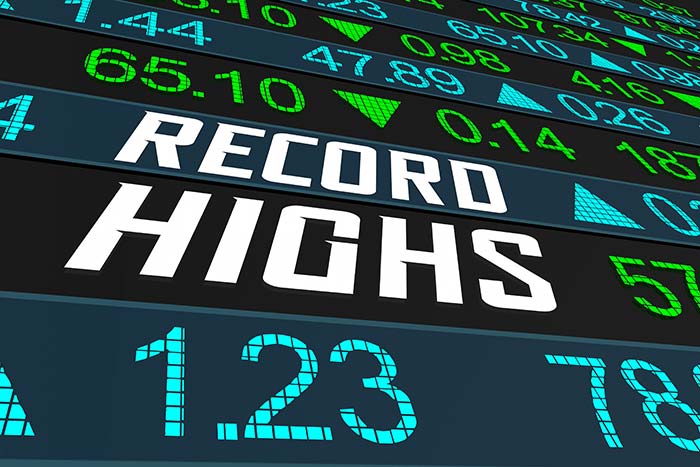A reader recently emailed me asking when the market bottom would be so that he would know when to invest.
Market timing is impossible. Trying to pick the bottom while markets are at all-time highs is as easy as trying to convince the middle school bully to stop stuffing you in a locker by telling him that what he really wants is a hug from his father. It’s not going to end well.
Typically, when the bottom of the market arrives, most investors are too scared to invest, because it feels like the selling will never stop.
But it’s understandable why folks are hesitant to invest now, with the market at all-time highs. After all, the saying is, “Buy low, sell high.”
In reality, though, there’s nothing wrong with “Buy high, sell higher.”
And the odds of that happening are pretty good.
If you were to invest only on the days the market hit an all-time high, you’d do better than if you invested on all other days. Over three- and five-year periods, you’d earn nearly 2 percentage points more by investing at the highs.
All-time highs occur during bull markets, so it makes sense that stocks continue to rise after a new high. Bull markets don’t last indefinitely, of course, but they can last a while – often longer than anyone expects.
I’m not saying you should only buy on days when the market reaches a new all-time high. But you also shouldn’t avoid putting money to work just because the market is at a high.
Investors get in their own way too often.
Last week, I featured a chart that showed that over 30 years, the typical investor earned an average of 2.5% per year, despite the market returning an average of 11%. That’s because investors make emotional decisions. They’re scared to buy when the market is too high, so they wait for it to come down… but then they won’t buy when it’s down and they wait for it to rise significantly again.
You should invest when you have money to put to work or on a regular basis, such as quarterly or monthly. Do that religiously, and ignore whether the market is up, down, sideways, or at all-time highs.
Over the long term, if you buy the market no matter where it’s trading, you won’t go wrong.


I began purchasing public traded equities when I was 13 1/2. I was bored at a week long Big Bear in CA vacation with my parents so I perused the LA Times financial section and found only 6 to 9 American Stock Exchange stocks positive per day over a week (financials and transportation. I charted them daily and purchased $300 using my bar mitzvah money in mid-1969. By the time I was 17, I had $7,000 (Hecla Mining was my biggest winner from 6 7/8 to 52) I chose winner only based on fundamentals other than Hecla which I didn’t know that the Hunt brothers were trying to corner the silver market. Well, then computer trading and shorting, etc. changed the market for me and I left until my late 40s when I decided to venture back into the market, but this time playing options as well. I own 27 properties, residential and commercial and find public equity trading a casino which is the only gambling I do. I currently own NVDA, TSLA, ABBV, EXAS, DD among my biggest positions. I sold much and purchased into 27 private equity investments including SpaceX/Starlink in 2015, Med-X 2016, GATC Health, Green Life Farms, Earth to Energy, Cohere, Anthropic, Ripple, and a host of smaller companies. I agree that buying high can be good as well as selling Calls while they are going up. I never day traded and prefer long term capital gains.
Thank you. As usual, well thought out. Enjoy the Summer
The beauty about investing for dividends is that market timing becomes a lot less relevant. Does the company pay out? Is the payout ratio sustainable? Are they carrying a lot or a little debt? Is their management team reasonably competent? I Like it because its MATH. Its not about who’s popular or trending. Also, you can set goals. My near future goal is to have enough dividends coming in to pay the taxes and insurance on my home. See how simple?